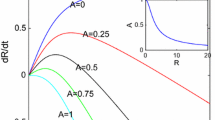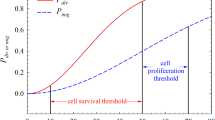Abstract
We study solid tumor (carcinoma) growth in the nonlinear regime using boundary-integral simulations. The tumor core is nonnecrotic and no inhibitor chemical species are present. A new formulation of the classical models [18,24,8,3] is developed and it is demonstrated that tumor evolution is described by a reduced set of two dimensionless parameters and is qualitatively unaffected by the number of spatial dimensions. One parameter describes the relative rate of mitosis to the relaxation mechanisms (cell mobility and cell-to-cell adhesion). The other describes the balance between apoptosis (programmed cell-death) and mitosis. Both parameters also include the effect of vascularization.
Our analysis and nonlinear simulations reveal that the two new dimensionless groups uniquely subdivide tumor growth into three regimes associated with increasing degrees of vascularization: low (diffusion dominated, e.g., in vitro), moderate and high vascularization, that correspond to the regimes observed in vivo. We demonstrate that critical conditions exist for which the tumor evolves to nontrivial dormant states or grows self-similarly (i.e., shape invariant) in the first two regimes. This leads to the possibility of shape control and of controlling the release of tumor angiogenic factors by restricting the tumor volume-to-surface-area ratio. Away from these critical conditions, evolution may be unstable leading to invasive fingering into the external tissues and to topological transitions such as tumor breakup and reconnection. Interestingly we find that for highly vascularized tumors, while they grow unbounded, their shape always stays compact and invasive fingering does not occur. This is in agreement with recent experimental observations [30] of in vivo tumor growth, and suggests that the invasive growth of highly-vascularized tumors is associated to vascular and elastic anisotropies, which are not included in the model studied here.
Similar content being viewed by others
Author information
Authors and Affiliations
Additional information
Received: 1 May 2002 / Revised version: 26 August 2002 / Published online: 18 December 2002
Current address: Department of Biomedical Engineering, and Department of Mathematics, University of California at Irvine, Irvine CA 92697. e-mail: cristini@math.uci.edu; lowengrb@math.umn.edu.
Key words or phrases: Tumor growth – Linear stability analysis – Self-similarity – Boundary-integral simulations
Rights and permissions
About this article
Cite this article
Cristini, V., Lowengrub, J. & Nie, Q. Nonlinear simulation of tumor growth. J. Math. Biol. 46, 191–224 (2003). https://doi.org/10.1007/s00285-002-0174-6
Issue Date:
DOI: https://doi.org/10.1007/s00285-002-0174-6




